The high post player moves into position in the outer half of the free throw circle. Upon reaching this position he is passed the ball from either guard. The pivot man is facing mid-court, back to the basket, and with feet spread for good balance. He must be extremely protective of the ball.
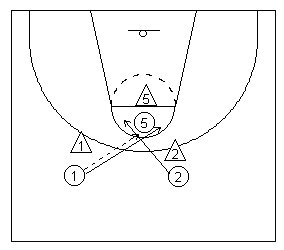 |
| Diagram 16 - Basic Scissor Movement - This play involves the high post man and both guards. Player 1 passes the ball into the pivot, who has moved toward the pass, and immediately cuts off the pivots left hip. At the same time teammate 2 fakes right but cuts behind player 1 and off the pivot's right hip to complete the scissor movement. The passer always cuts first. The pivot must quickly read the defense to determine whether the first or second cutter will be in the better position to score. Also, he must be aware of his own defender's reaction. After handing off to either guard he should open toward the ball, move toward the basket, allowing for a return pass (generally a high lob) should his defender switch to the cutter. He is also in good rebounding position in case the guard in possession shoots the ball. |
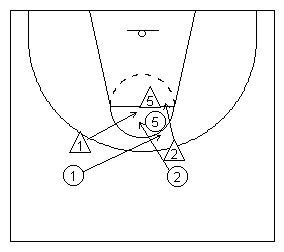 |
| Diagram 17 Scissor Movement with Shot over Double Screen - Pivot player 5 receives a pass from guard 2 who cuts as in the original scissor movement. Guard 1 fakes and completes the scissor. His defender 1 slides back behind offensive guard 1 and pivot player 5 to negate the effectiveness of the cut. Offensive player 1 stops, takes a pass from 5 and shoots an 18 foot shot over the double screen set by teammates 2 and 5. |
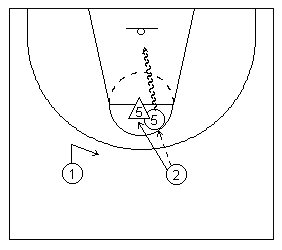 |
| Diagram 18 Scissor Cut Pivot Technique - Offensive player 2 has passed to pivot player 5 and started his cut. The pivot player observes his defender moving to the right in anticipation of 2's cut. On seeing this development, offensive player 1 delays his cut. Pivot player 5 pivots on his right foot and steps toward the basket with a long left stride. He can either dribble in for a lay up or take a jump shot. |
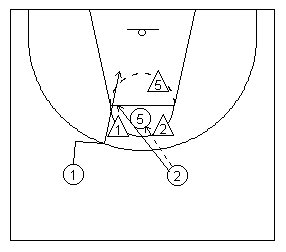 | |
| Diagram 19 Scissor Movement where Defenders Prematurely Anticipate the Scissor - Offensive player 2 passes into the pivot player and makes his cut. Teammate 1 starts his cut behind teammate 2. He observes that defender 2 has stopped following teammate 2 and that his own defender, 1, will pick up teammate 2. Guard 1 then changes direction and cuts to the same side of the pivot player as teammate 2. |
The guard fakes and times his cut behind the forward. Many good shooting opportunities open up because of this movement. If the forward receives the hand-off pass as the first cutter, he is in excellent range for a simple fake and jump shot.
The guard, cutting behind the forward, is also is within good shooting range should the defense fall back. If the don’t and are properly screened he is wide open for a driving lay-up.
The pivot player should open toward the hand off and step toward the basket as he will have inside position should his defender switch. Many shooting opportunities such as the step-in-direction hook shot, baby hooks, or turnaround jumpers, become available to a good pivot player.
It is important that the two teammates, not involved in this play, lure their defenders away from the point of attack and maintain good defensive balance of the floor should the ball be intercepted or possession lost through rebounding action.
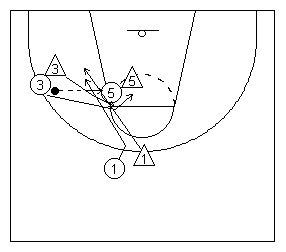 |
| Diagram 20 The Scissor Cut using Center, a Forward and a Guard - Forward 3 passes into the pivot. The forward cuts to the outside of his pass. Teammate 1, the guard, fakes opposite then cuts off 3's movement. |
sumber : http://www.guidetocoachingbasketball.com/three_man.htm





No comments:
Post a Comment